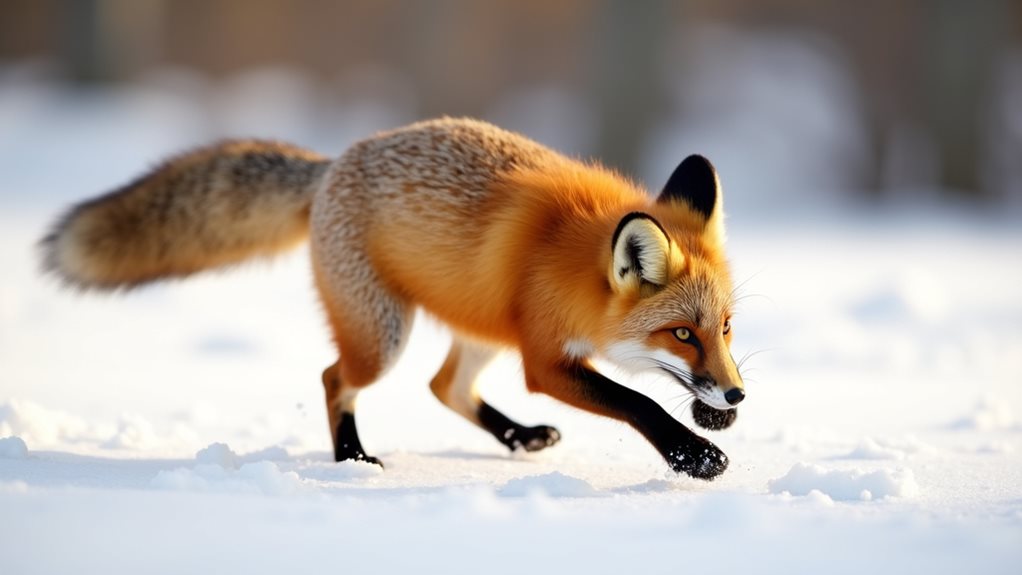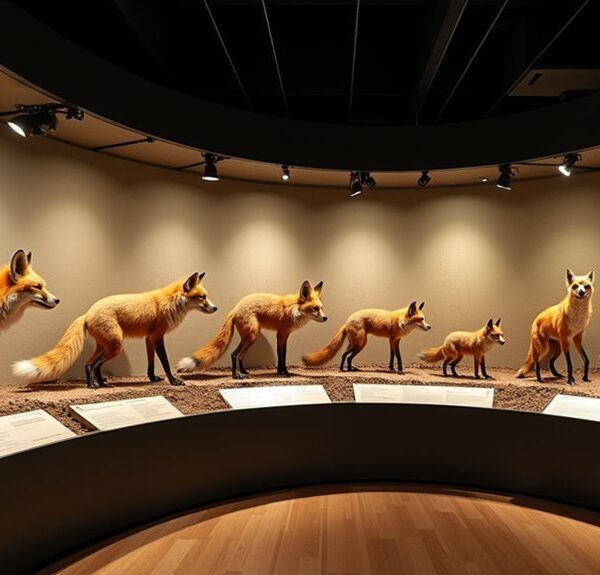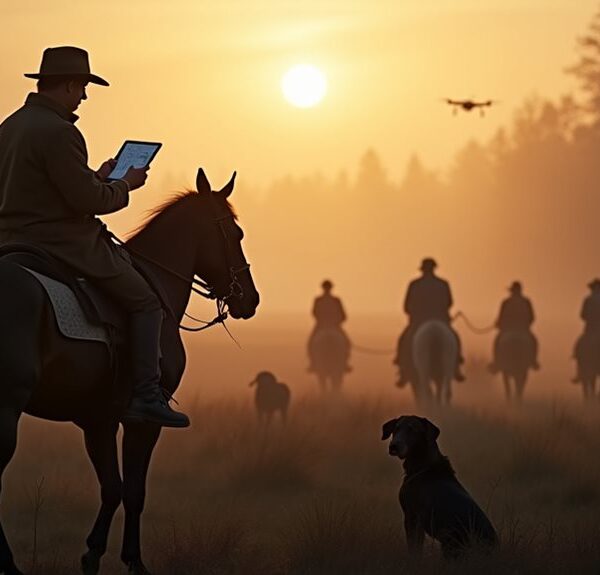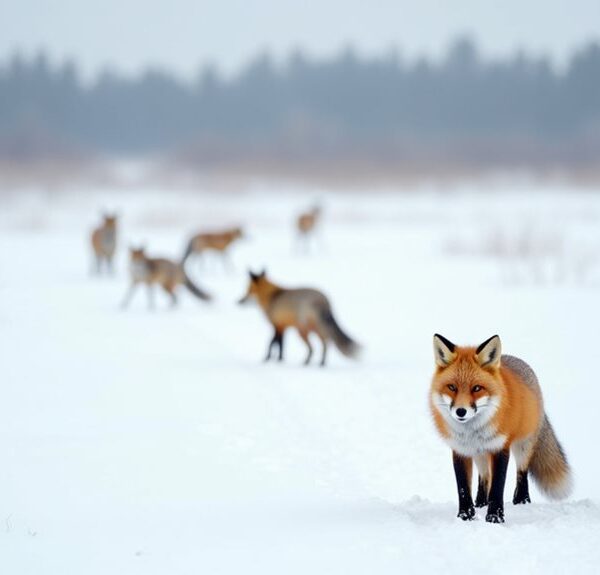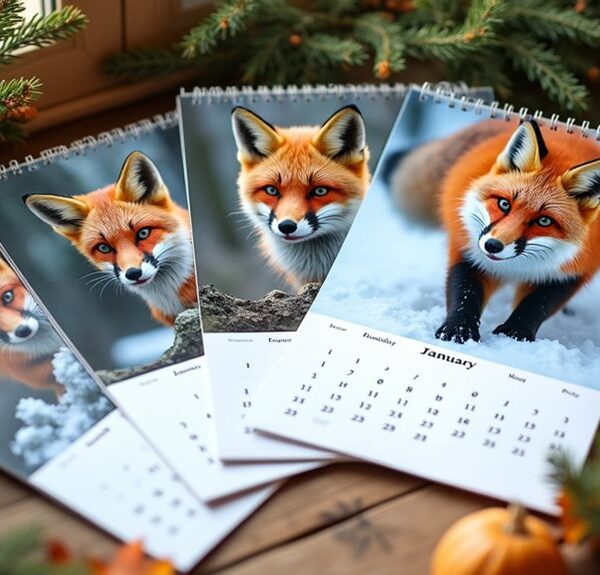Unlike their canid relatives who hunt in packs, foxes are solitary predators with unique hunting skills. You’ll notice their distinctive “mousing leap” allows them to pounce precisely on prey hidden under snow or vegetation. They’re incredibly adaptable, shifting their diet seasonally and employing strategic food caching when resources are plentiful. Their remarkable hearing can detect mice beneath a foot of snow, while their hunting approach prioritizes patience and ambush over stamina. These clever hunters have much more to reveal about their predatory prowess.
Contents
- 1 The Solitary Hunter: Fox Hunting Strategies vs. Pack Predators
- 2 The Remarkable “Mousing Leap”: Precision Hunting Techniques
- 3 Dietary Opportunism: How Foxes Adapt Their Feeding Habits
- 4 Food Caching Behavior: Strategic Meal Planning in the Wild
- 5 Urban Adaptations: How Fox Predation Changes in Human Environments
- 6 Ecological Impact: The Fox’s Role in Predator-Prey Relationships
- 7 Final Thoughts
The Solitary Hunter: Fox Hunting Strategies vs. Pack Predators

While wolves and coyotes hunt in coordinated packs, foxes employ a completely different approach to catching their prey.
You’ll notice foxes rely on solitary tactics that showcase their remarkable adaptability in various environments. They’ve perfected the famous “mousing leap,” where they pounce precisely on prey hidden beneath snow or vegetation.
Their hunting efficiency comes from patience rather than stamina. Unlike their pack-hunting cousins who can chase prey for miles, foxes are masters of the ambush.
They’ll quietly stalk their target, freeze in position, and then spring into action with impressive accuracy. This solo approach allows them to conserve energy while maximizing success rates. Interestingly, foxes can consume around 0.5 to 1 kilogram of food daily, demonstrating their diet variability in response to environmental challenges.
You might be surprised to learn that a fox’s hearing is so acute, they can detect a mouse moving under a foot of snow!
The Remarkable “Mousing Leap”: Precision Hunting Techniques
When you observe a fox hunting in the wild, you’re witnessing one of nature’s most refined predatory techniques in action. The fox’s signature “mousing leap” is truly a marvel of precision hunting.
You’ll notice how the fox carefully stalks its prey, ears perked forward to detect the faintest rustling beneath the snow or grass.
Then comes the spectacular moment—the fox launches itself high into the air, arching its body before plunging nose-first into the snow or tall grass. This isn’t random; it’s calculated physics!
The fox triangulates the exact position of its hidden prey using sound alone, then pounces with remarkable accuracy. Unlike wolves or coyotes that rely on pack strategies, this solo technique showcases the fox’s extraordinary adaptation. Additionally, the fox utilizes its high rod density to enhance its low-light vision, allowing for effective hunting even in dim conditions.
Next time you’re lucky enough to spot this behavior, you’re seeing natural precision at its finest!
Dietary Opportunism: How Foxes Adapt Their Feeding Habits
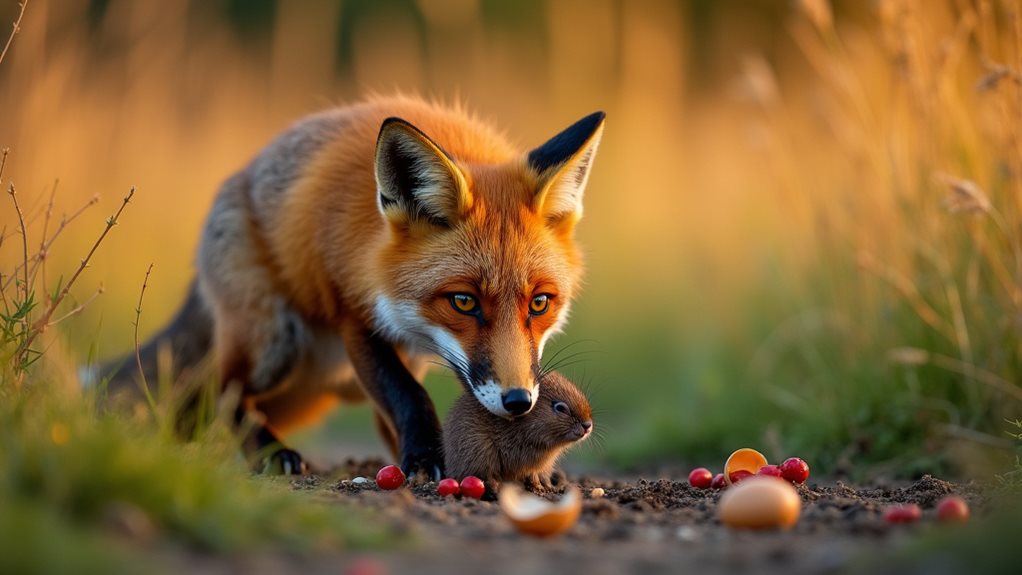
The impressive precision of a fox’s hunting leap represents just one facet of their remarkable survival toolkit.
You’ll find these clever canids excel at dietary flexibility, shifting their menu based on what’s available. Unlike wolves who primarily target large prey, foxes happily consume everything from rodents and rabbits to berries, insects, and even human leftovers.
This foraging flexibility makes foxes incredibly successful in diverse environments, from forests to urban neighborhoods.
They’ll adjust their hunting tactics according to seasonal variations, focusing on abundant berries in summer while relying more heavily on small mammals during winter months. When one food source becomes scarce, they simply pivot to another.
You might spot a fox hunting rodents in a field one day and raiding your compost bin the next—they’re nature’s ultimate opportunists, turning dietary challenges into survival advantages. Their flexible, omnivorous diet allows them to thrive across various habitats and conditions.
Food Caching Behavior: Strategic Meal Planning in the Wild
You’ll be amazed at how foxes plan for future meals through their clever surplus killing tactics.
When prey is abundant, these cunning canids will hunt more than they can immediately eat, storing extra food in scattered caches throughout their territory.
These strategic storage patterns allow foxes to return for meals during leaner times, much like your own pantry serves as insurance against unexpected hunger.
Surplus Killing Tactics
Foxes’ remarkable food caching behavior represents one of nature’s most fascinating survival strategies, allowing these clever canids to plan for uncertain times ahead.
Unlike other predators, foxes employ unique surplus strategies when hunting prey, displaying exceptional hunting efficiency that sets them apart from their canid relatives.
When you observe fox hunting patterns, you’ll notice four distinctive surplus killing tactics:
- Rapid prey dispatch – foxes can kill multiple rodents within minutes
- Precise burial techniques – they’ll hide excess food up to 40 different locations
- Memory-based retrieval – they remember cache locations for weeks
- Seasonal intensification – they’ll increase surplus killing before winter
You’ll find these tactics most impressive during seasons of abundance, when foxes prepare for leaner times by creating nature’s version of a pantry, storing away meals for when they’ll need them most. Furthermore, red foxes are omnivores and their adaptability in diet allows them to thrive even in varying environmental conditions.
Long-term Storage Patterns
While surplus killing reveals the immediate tactical genius of foxes, examining their long-term storage patterns shows an even more sophisticated survival strategy at work. Unlike their canid cousins, foxes excel at long-term caching, carefully burying excess food in scattered locations they’ll remember even months later.
You’ll notice foxes aren’t just random hoarders—they’re strategic planners. Their seasonal storage behaviors shift dramatically with the calendar. In summer and fall, you’ll find them frantically caching surplus kills, creating insurance against winter scarcity.
They’ll carefully select storage sites based on soil temperature, moisture, and protection from competitors. Notably, this behavior can be observed in various species such as the red fox, which thrives in diverse habitats and adapts its caching techniques to its environment.
What’s fascinating is how they’ll prioritize different food types for different storage durations, showing they understand which items preserve better than others. This isn’t just food storage—it’s wilderness meal planning at its finest!
Urban Adaptations: How Fox Predation Changes in Human Environments
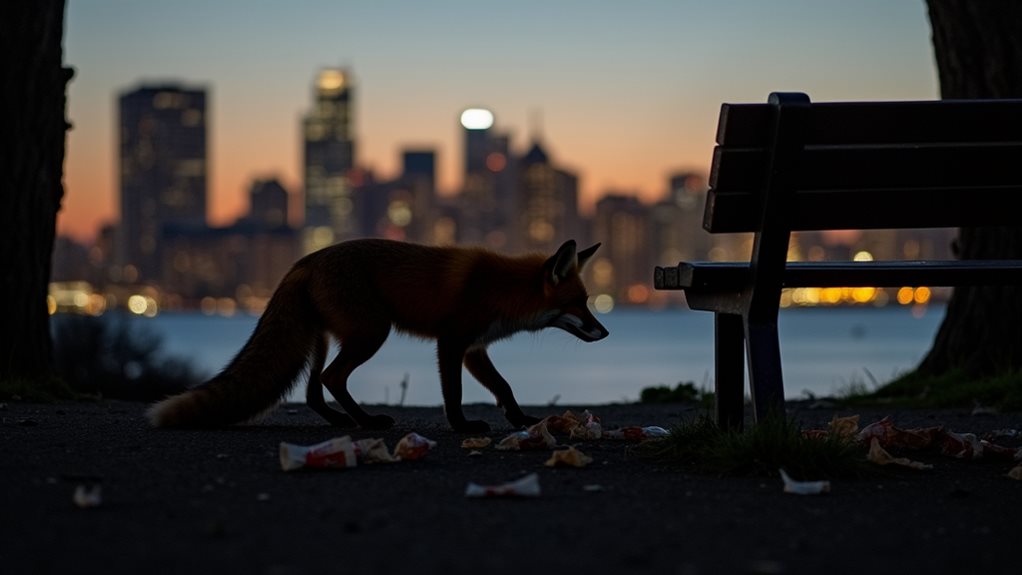
As urbanization continues to reshape natural terrains, red foxes have remarkably adapted their predatory behaviors to thrive in human-dominated environments.
You’ll notice their urban foraging techniques differ greatly from their rural cousins. They’ve become opportunistic omnivores in cities, expanding their diet beyond traditional prey.
Here’s how foxes have transformed their hunting in urban settings:
- They’ve shifted to nighttime hunting to avoid human interaction.
- They rely more on scavenging from garbage than active hunting.
- They target smaller prey like rodents and birds found in parks.
- They’ve developed shorter hunting ranges, often staying within a few city blocks.
These clever adaptations showcase foxes’ extraordinary ability to modify predatory behaviors while maintaining their ecological role in our concrete jungles. Urban foxes are particularly skilled at utilizing human-modified landscapes to find shelter and breeding grounds, illustrating their resilience and adaptability.
Ecological Impact: The Fox’s Role in Predator-Prey Relationships
You’ll notice that foxes shape the terrain as mesopredators, filling a critical niche between apex predators and smaller creatures.
Their hunting behaviors help regulate prey populations, keeping rodents and rabbits in check while preventing ecosystem imbalances.
When fox numbers change, you can observe ripple effects throughout the food web, creating what scientists call trophic cascades that impact everything from plant growth to insect abundance. This is particularly evident with the red fox, which is known for its adaptability in various environments, influencing the populations of numerous small mammal species.
Mesopredator Landscape Influence
Throughout ecosystems worldwide, foxes play a crucial role as mesopredators—the middle-weight hunters that balance food webs from the inside out. When you’re studying mesopredator dynamics, you’ll notice foxes are master adaptors, shifting their habitat selection based on both food availability and predation risk from larger carnivores.
Here’s how foxes influence their environments:
- They control rodent populations that might otherwise damage crops and spread disease.
- Their presence shapes the behavior of smaller prey, creating “environments of fear.”
- They disperse seeds through their scat, promoting plant diversity across territories.
- When apex predators decline, foxes often expand their ecological role to fill the gap.
Additionally, foxes exhibit unique adaptations that enable them to thrive in diverse environments, ultimately influencing ecosystem structure and function. You’ll find that these adaptable hunters don’t just survive in changing conditions—they actively reshape them.
Prey Population Regulation
The balancing act foxes perform in their ecological communities extends beyond their mesopredator status to their direct influence on prey populations.
You’ll notice foxes don’t just randomly hunt—they’re selective predators who target specific prey depending on availability, creating fascinating ripple effects throughout the ecosystem’s population dynamics.
When you study predator diversity in any habitat, you’ll find foxes play an essential role in preventing any single prey species from dominating.
Unlike wolves who might focus on larger game, foxes keep small mammal numbers in check, particularly rodents that could otherwise experience population explosions.
It’s like nature’s way of maintaining order! This regulation helps maintain plant diversity too, as unchecked herbivore populations would overgraze certain plant species.
The fox’s hunting patterns create a beautiful ecological harmony you won’t find with many other predators. Foxes, such as the gray fox, adapt their hunting techniques to thrive in various environments, ensuring their successful role in the ecosystem.
Trophic Cascade Effects
When foxes vanish from an ecosystem, the ripple effects can be both dramatic and far-reaching, demonstrating what ecologists call a trophic cascade.
You’ll notice these changes through altered trophic dynamics that reshape entire communities. Without foxes, ecological succession takes unexpected turns.
Here’s what typically happens when foxes disappear:
- Small mammal populations explode, often leading to crop damage and disease transmission.
- Ground-nesting bird numbers decline as rodent predation on eggs increases.
- Plant communities change as herbivore pressure intensifies, affecting which species thrive.
- Competing predators shift their behaviors, creating new patterns of dominance.
In the case of the Arctic fox, competition with invasive species exacerbates these cascading effects, further destabilizing the ecosystem dynamics.
You’re witnessing nature’s intricate balance in action! When you remove a predator like the fox, you’re not merely losing one species—you’re fundamentally changing how the ecosystem functions, creating cascading effects that might surprise you.
Final Thoughts
You’ve now seen how fox predation stands apart from other canids. Unlike their pack-hunting relatives, foxes have developed unique skills like the mousing leap and extensive food caching. Next time you’re walking at dusk in London’s Hyde Park, you might spot a fox using its specialized pounce to catch prey – an evidence of how these adaptable hunters thrive in both wilderness and urban jungles, balancing ecosystems wherever they go.

